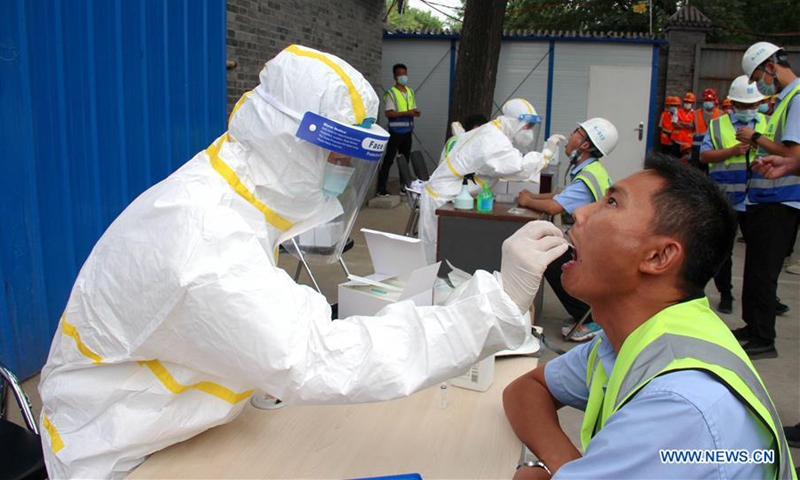Yang Gonghuan, former vice director of the Chinese Center for Disease Control and Prevention (CDC), told the Global Times on Monday that the recent spike in COVID-19 cases in Beijing is on a small scale and not the start of second wave of the epidemic, adding that the cases will continue to decline.

Medical workers collect throat swabs from construction workers at a construction site in Dongcheng District of Beijing, capital of China, June 17, 2020. From June 15 to 17, a total of 1,042 workers of China Construction Third Engineering Bureau Co., Ltd (Beijing) received nucleic acid tests for COVID-19. (Photo: Xinhua)
But Yang warned that the possibility of a second outbreak cannot be ruled out if the virus doesn't disappear before winter comes. "We need to remain serious about epidemic control and prevention while maintaining a relaxed mood."
Beijing reported nine new local cases on Sunday, the first day the number dropped below 10 during the recent spike in the epidemic, which reassured the public.
Wu Zunyou, chief epidemiologist at the China CDC, said on Thursday that the epidemic in Beijing was under control and claimed the peak of the Beijing cases was on June 13.
When asked if the number of cases on Sunday supported Wu's comment, Yang gave a positive answer. "Beijing's confirmed cases are declining. Also, as the transmission chain in Beijing is very clear, I think the number of cases will continue to drop."
Yang said all the cases in Beijing are linked to the Xinfadi wholesale market, which is good news.
He noted that generally, the most worrying thing would be infection from unknown sources or multi-site emergence of infection. "But in Beijing, this is not the case." Yang said the outbreak is part of "the first wave, not the second."
As the pandemic continues globally, imported asymptomatic cases are inevitable, he said.
Beijing has taken strict measures and launched a thorough epidemiological investigation following the new spike, Yang noted.
The central government and local authorities all used terms such as "severe" and "complicated" when describing the recent outbreak, but Yang said the spike was sudden and the source of infection remains unclear, which poses a big challenge to epidemic prevention and control work.
"However, on the whole, viruses have coexisted with human beings for a long time, and a local rebound of the epidemic is inevitable. So we must stick to normalization of epidemic prevention and control. From this point of view, I think the epidemic is not so terrible, and I always call on the public not to panic," Yang noted.
He affirmed Beijing's response in terms of the epidemiological investigation, quarantine measures and tracing of the virus' source.
"While many questions remain unanswered about the Beijing spike, the epidemic didn't cause a community-level cluster infection or multi-area outbreak, and the transmission chain is clear and there has been timely tracing of close contacts," Yang said, noting that the next task is to observe whether the close contacts become infected.
Beijing had reported zero new domestic case for 56 consecutive days before the recent outbreak. But Yang said that such a spike is not unexpected given the global epidemic situation.
Many places in China have been reporting zero domestic cases since February. But it is impossible that China can totally eliminate domestic cases while the epidemic is still spreading outside the country, Yang said.
The transmissibility of the virus is comparatively weaker in summer than in winter, according to Yang.
As to the experiences learned from the outbreak this time, Yang noted that disinfection in places full of many types of people, such as wet wholesale markets, must be taken seriously. Control of flows of population or social distancing measures have to be implemented properly in these places.
"It is only half a year since the virus emerged so we don't know enough about it. The Beijing authorities have collected a large number of samples and have conducted genotyping, but it is still uncertain whether we can find the infection source or patient zero. More evidence is needed," Yang said.


